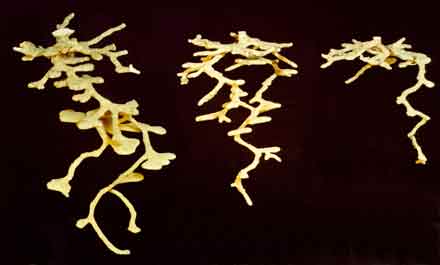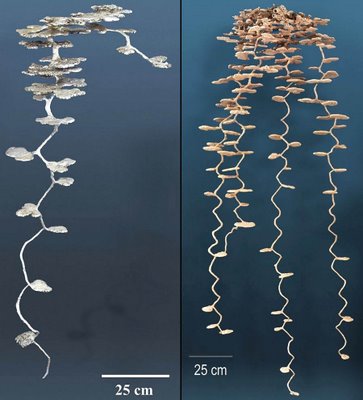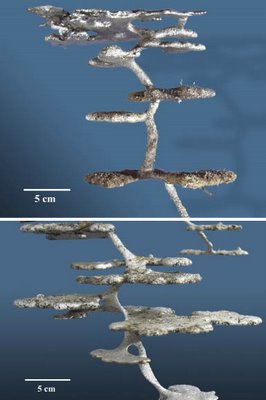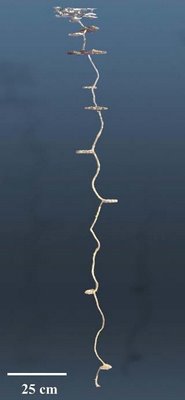Nest-casting

In the Fall of 2001, Cabinet Magazine introduced us to Walter Tschinkel, a professor of entomology at Florida State University. Tschinkel "has been making plaster casts of ant nests since 1982, when he first heard of the strength of orthodontic plaster. The painstaking process involves pouring the plaster down the opening as quickly as it will go in. After the plaster hardens, the excavation begins, but the nest must be taken out piece by piece. (One harvester ant nest, for example, took some five gallons of plaster and came out in 180 pieces.)"

"Sometimes more than ten feet tall, the nests are as beautiful in structure as they are complex."

In a fascinating research paper (available through Florida State University as a PDF), Tschinkel describes subterranean ants' nests as "shaped voids in a soil matrix." These casts, Tschinkel tells us, offer "an invaluable way to visualize ant colonies as they are, that is as a three-dimensional network of tunnels and chambers."

In an even more interesting – not to mention better illustrated – paper (also available as a PDF) Tschinkel takes us on a verbal tour of this buried architecture: "In contrast to shafts," he writes, the chambers all "had more or less horizontal floors and a horizontal outline ranging from near circular when small, to multi-lobed when large. In vertical cross-section, they were flattened or slightly domed, with the horizontal dimension much greater than the vertical. All chambers were about 1 cm high, floor to ceiling, no matter what the floor area. Shafts usually intersected chambers at an edge, and connected sequential chambers. Below about 15 to 20 cm, chambers always began as lateral, horizontal-floored extensions from the outside of a spirally-descending shaft that therefore intersected the inner edge of the chamber at an angle ranging from 25º to about 70º."

The social behavior of the ants is, in many ways, what produces the structures. Tschinkel refers to "movement zones," in which "partially overlapping sequences from the center of the nest to the periphery" are traced and retraced by individual ants. These movements gradually erode at the walls, expanding surfaces into actual rooms. These "spaces," then, are really the physical results of social activity, in which a surface becomes a route becomes a chamber – and further branchings spread outward (or downward) from there. (Substantially more information on this – including the influential role of carbon dioxide – can be found in this PDF).

"Chamber morphology," meanwhile, "was rarely elongated and shaft-like." Rather, each chamber "began as a niche in the outer wall of a shaft." Etc. etc.
The process of making these casts almost always kills the ants in the nests, however; but that is "not something I like doing," Tschinkel says.
Of course, the urge toward revealing invisible architecture can overwhelm even the best...
(Thanks to jpb for the link! And this post is directly related to an earlier post, Wormholes in Wood, which discusses the more conceptual aspects of such a project).

Comments are moderated.
If it's not spam, it will appear here shortly!
I was going to say that seems rather hard on the ants, doesn't it?
John, the displaced ants are all housed in temporary FEMA trailers.
What happens to the ants?
Did this come from the Athanasius Kircher Society?
http://www.kirchersociety.org/blog/?p=362
Anon, nope - but clearly they covered it, too. Thanks for the heads up.
amazing - digg!!
That's what I want my next house to look like! Except above ground. And with toilets. And stainless steel appliances. And a urinal in the basement for my guy. And lots of windows. Ah fark, I'll just take a treehouse. Cool stuff anyhow.
I can't say I find any of these structures to be anything close to approaching "beautiful."
They are interesting, to be sure, within the context of their origins, but aesthetically they're just plain, well, ugly. And redolent of bugs. Obviously.
I've always found it strange when the entirely human concept - and execution - of beauty gets pompously twisted to encompass the least attractive manifestations of Nature, just cuz they're manifestations of Nature.
Kind of moots the whole pursuit, dontcha think?
So you're saying it can only be beautiful if it's human? That there's no beauty in nature?
"I've always found it strange when the entirely human concept - and execution - of beauty gets pompously twisted to encompass the least attractive manifestations of Nature, just cuz they're manifestations of Nature."
I like the observation, but just don't see that as a negetive. I am all in support of finding manifestations of nature beautiful under most cicumstances. Especially when the manifestations are so strikingly different from human works. Conceptually that so exciting to me, I can't imagine ranking it aesthetically...
Is this an argument for design in nature?
Personally, though this in no way invalidates the argument, I think the original phrasing got lost in the tussle: the author of the article says that the nests are "beautiful in structure," which has a very different meaning than something being "beautiful." That's not exactly the most interesting point in the world, but it's worth bearing in mind. Something horrific and even ugly can be quite beautiful in structure.
If you lived in Florida you'd find it hard to appreciate anything concerning ants. It seems as if the ant population is being taken over by fire ants, whose bite is almost as bad as a bee sting, and becomes a pustule that has to be broken and cleaned out--and that's if you're NOT allergic to them! Imagine what it's like when your child gets into a nest of them.
I try to destroy them [near the house, at least] by running water into the nest, feeding the hose in until no more eggs float out. I have put 10 to 15 feet of hose into some nests.
Another strange attraction for these ants is electrical lines. I had a pump motor on a well burned out when several hundred crawled up the power lines and got into the switch, shorting it out.
If Dr. Tschinkel feels bad about killing them, he is surely one of the few Floridians who feel that way.
the first link posted by some one anonymous ...about the fabric anir system .. is realy cool!
What happens to the ants?
This was a quote from one of his papers. I thought it was very funny...
"It is not possible to derive a census from metal casts (although tiny, charred carcasses were often visible), so these casts provide only structural information without information about the colony that built the nest."
I think Tiny Charred Carcasses would make a great name for a band.
Dr. Tschinkel then is perhaps more conscious of the infallibility of karma. Though he feels compelled to make a living through genocide, he is mindful of the harm he is doing and would, should the opportunity arise, find another way to support himself. His circumstances are bleak, but he looks for a better way.
However, those who defy their own empathy and abuse the stewardship of their environments are through the cycles of time more likely to find themselves reborn without choice and in a world of unforgiving genocide.
As all things arise from mind, our intentions, kind or cruel, always win out over the manifest world. Until that karma ripens, may we all suffer mindfully.
Post a Comment